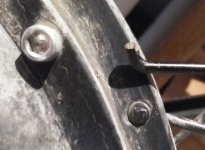markz
100 TW
I currently have 8 broken spokes on a Leafbike laced 26" wheel, rear hub.
Have had it now for, 3-4 months I'd guess.
Same old problematic broken spokes I've always been having for years for 380lbs. This time though, its a new kind of damage I've never experienced.
Leafbike does 12G, the rim is brand name non-V-brake rim, disc only. Not sure what brand (if any) spokes they use.
Interesting spoke breakage (see pictures below) - Right at the top of the J-bend. In some circumstances right above the bend, so the entire spoke, plus a hair of the bend was intact.
Riding - I was babying it, not wanting broken spokes AGAIN! I would slow down for curbs, and sidewalk edges/buldges, wouldnt even do corners at 30kph, hardly ever want any sideways load.
I might as well go cast wheel, I do have a 19" motorcycle rim, requires purchase of 125mm spokes.
Quick and easy solution is the "18 inch casted hub with magnet" - Item ID #LBMP-18INCH - $95usd
The biggest downfall is if I hit the rim, or get a crack in the cast, then s.o.l.
https://www.leafbike.com/products/e-bike-hub-motor/18-inch-casted-hub-with-magnet-976.html




Have had it now for, 3-4 months I'd guess.
Same old problematic broken spokes I've always been having for years for 380lbs. This time though, its a new kind of damage I've never experienced.
Leafbike does 12G, the rim is brand name non-V-brake rim, disc only. Not sure what brand (if any) spokes they use.
Interesting spoke breakage (see pictures below) - Right at the top of the J-bend. In some circumstances right above the bend, so the entire spoke, plus a hair of the bend was intact.
Riding - I was babying it, not wanting broken spokes AGAIN! I would slow down for curbs, and sidewalk edges/buldges, wouldnt even do corners at 30kph, hardly ever want any sideways load.
I might as well go cast wheel, I do have a 19" motorcycle rim, requires purchase of 125mm spokes.
Quick and easy solution is the "18 inch casted hub with magnet" - Item ID #LBMP-18INCH - $95usd
The biggest downfall is if I hit the rim, or get a crack in the cast, then s.o.l.
https://www.leafbike.com/products/e-bike-hub-motor/18-inch-casted-hub-with-magnet-976.html










